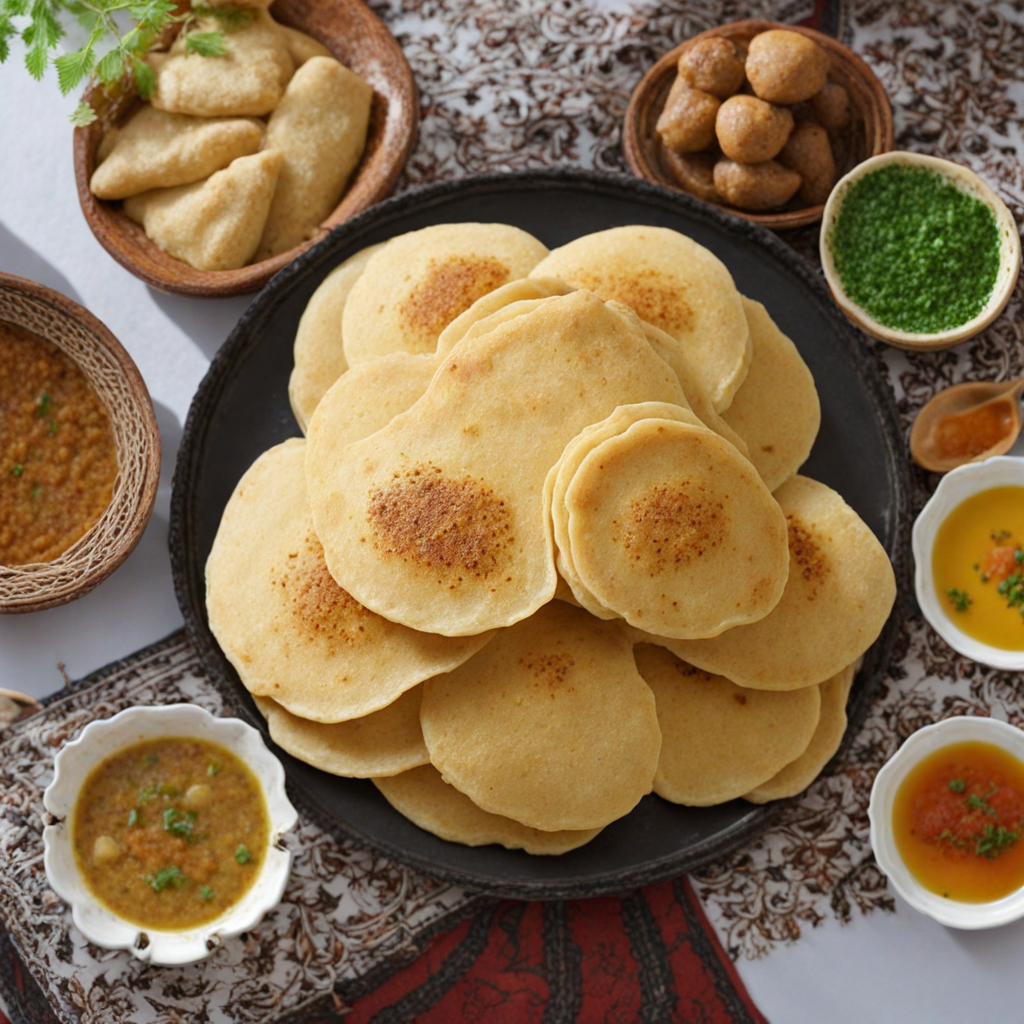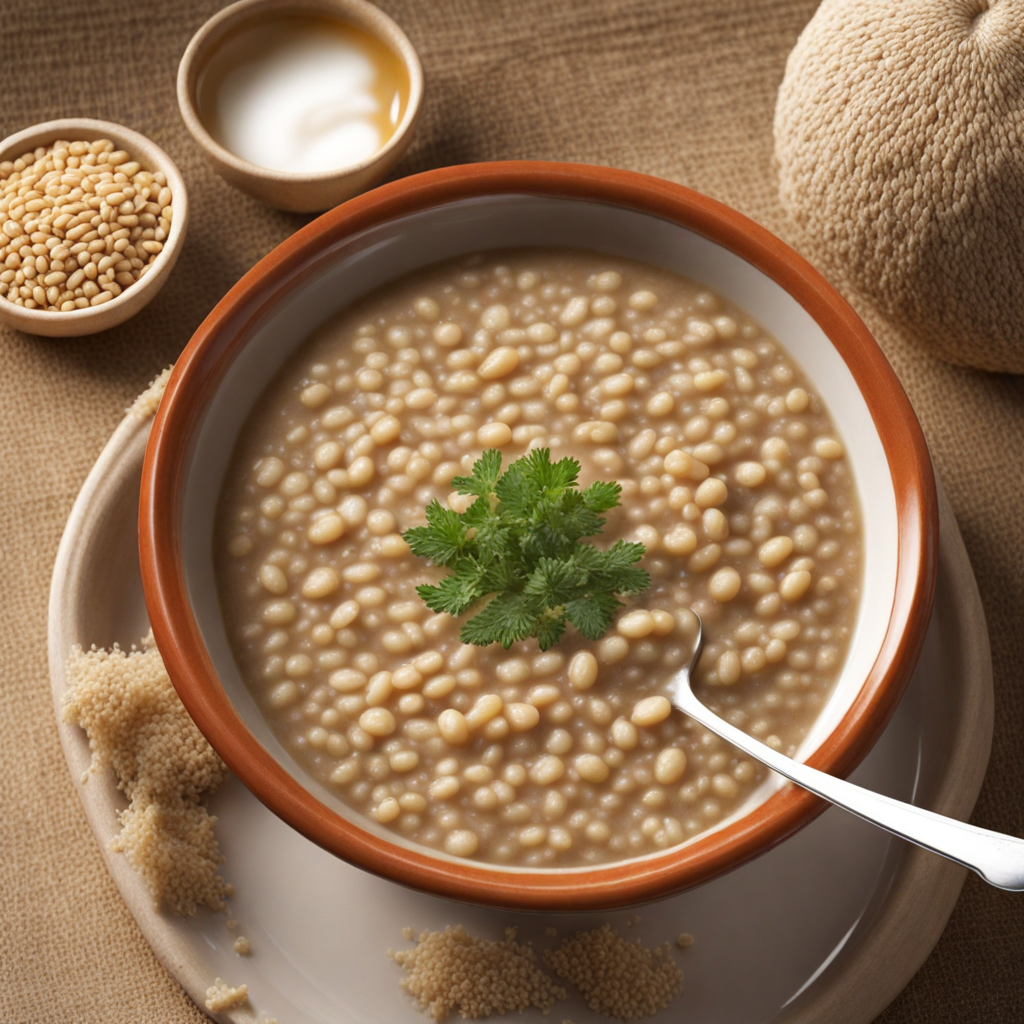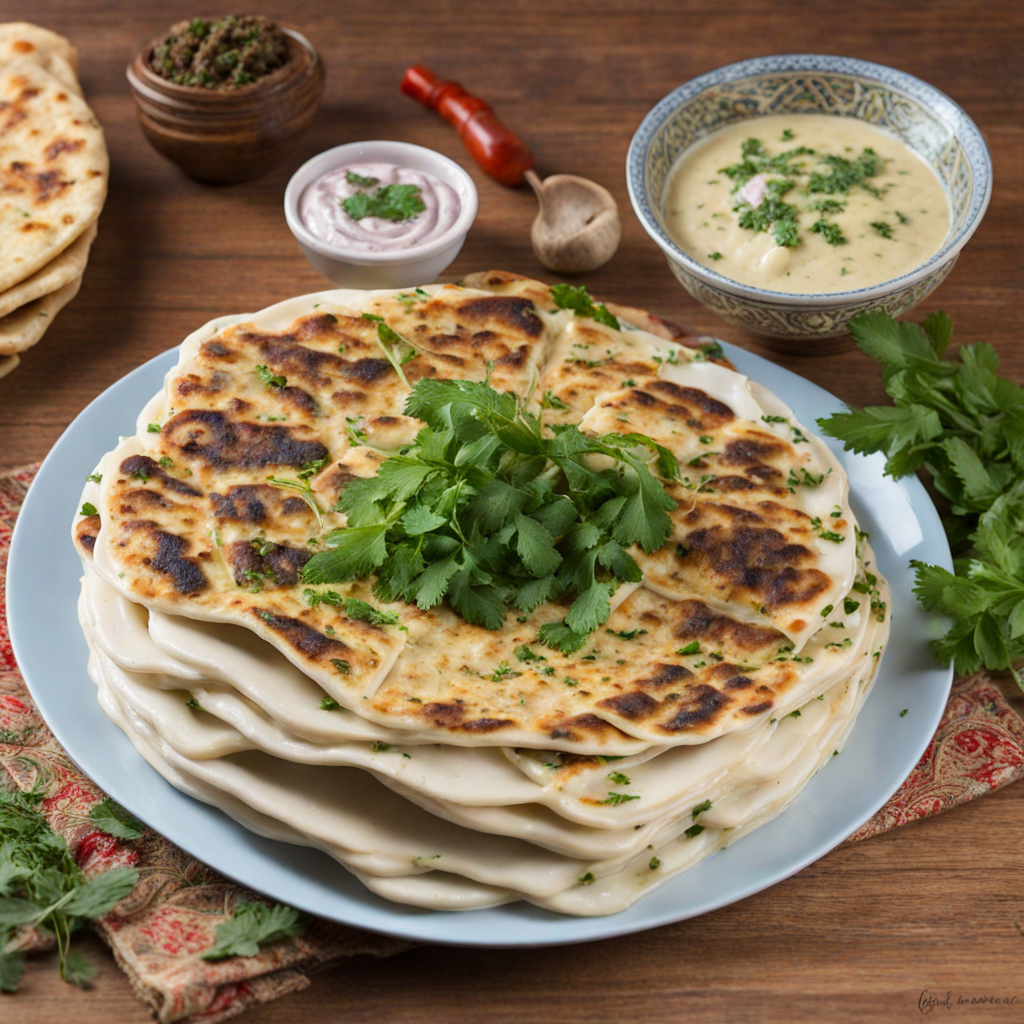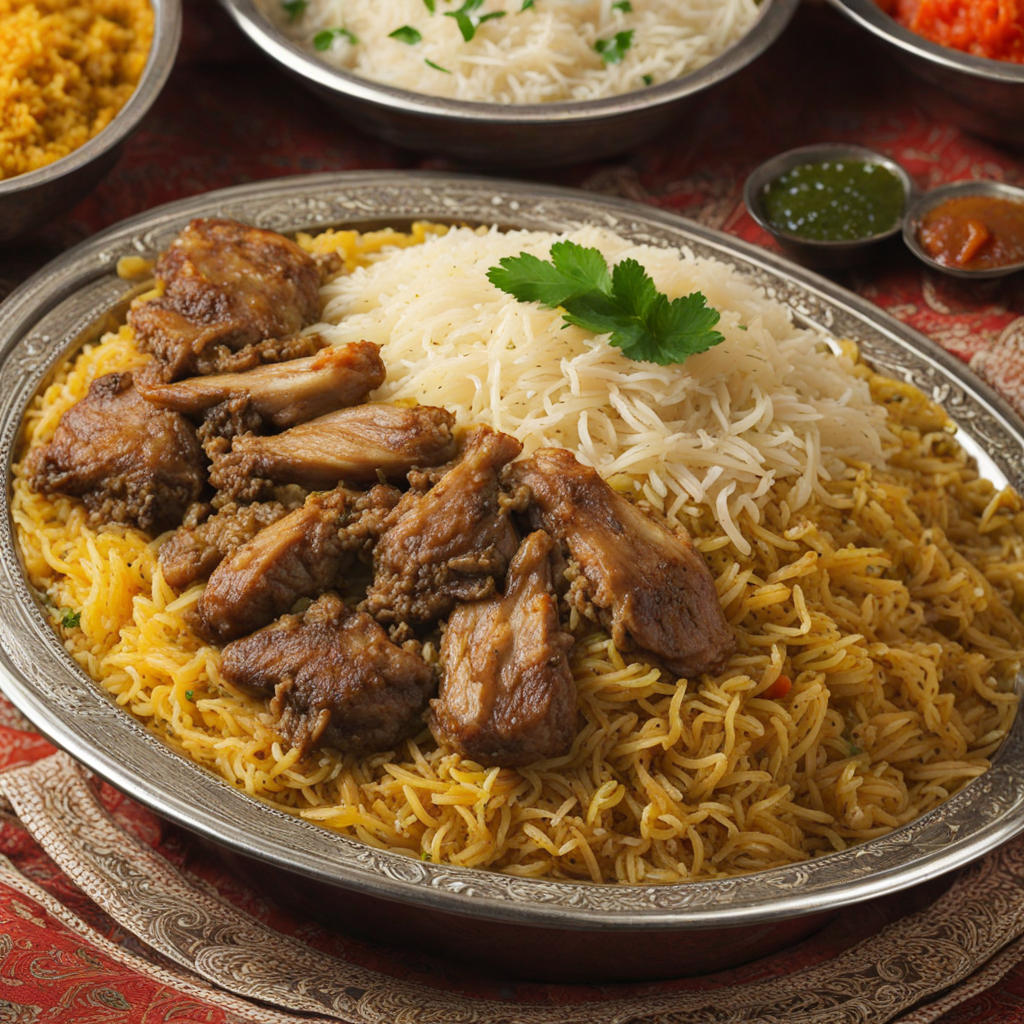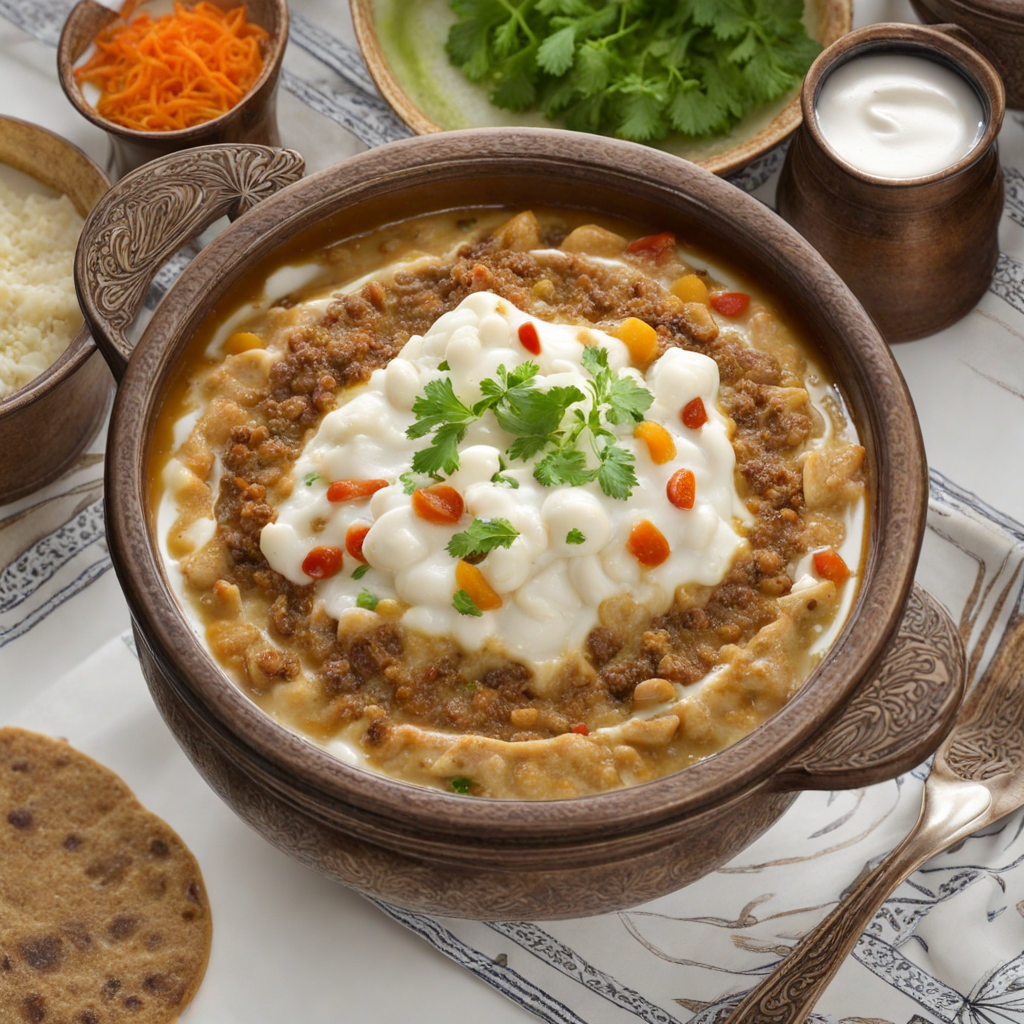Lahoh
Lahoh is a traditional Yemeni flatbread that captivates the palate with its unique texture and flavor. This spongy bread is made from a simple mixture of flour, water, and yeast, allowing for a delightful fermentation process that gives it a slightly tangy taste. The dough is poured onto a hot skillet or griddle, where it cooks quickly, forming numerous small bubbles that create a soft and porous structure. Its vibrant yellow hue, often enhanced by the addition of turmeric, invites you to experience its delightful taste. The versatility of Lahoh makes it an essential part of Yemeni cuisine, often served as a side dish or used to scoop up various stews, salads, and meats. Its mild flavor pairs well with a myriad of accompaniments, from savory dishes like spiced lamb or chicken to sweet toppings such as honey and yogurt. The bread’s unique texture allows it to absorb flavors beautifully, making every bite an explosion of taste. Whether enjoyed at breakfast, lunch, or dinner, Lahoh is a comforting staple that brings warmth to the table. As you savor Lahoh, you’ll notice how it embodies the essence of Yemeni culture—simple yet rich in flavor. This bread is not just a food item; it represents community and tradition, often made in large batches to share with family and friends. Its preparation is a labor of love, and each piece holds stories of gatherings and celebrations. Discovering Lahoh is not just about tasting a new food; it is an invitation to explore the rich culinary heritage of Yemen, one delicious bite at a time.
How It Became This Dish
Lahuh: A Culinary Journey Through Time in Yemen Lahuh, a traditional Yemeni flatbread, is much more than just a staple food; it is a vibrant symbol of Yemen’s rich cultural tapestry and a reflection of its historical evolution. This spongy and slightly fermented bread has been a beloved part of Yemeni cuisine for centuries, embodying the essence of community, tradition, and resilience. Origins and Early History The origins of lahuh can be traced back to the ancient Arabian Peninsula, where grains like wheat and barley were cultivated. Yemen's unique geographical landscape, characterized by its mountainous regions and fertile valleys, allowed for diverse agricultural practices. Historically, the people of Yemen relied on grains as a primary food source, leading to the development of various bread-making techniques. Lahuh is believed to have derived from the broader category of fermented flatbreads that are common in many Middle Eastern and North African cuisines. It shares similarities with other regional breads, such as injera in Ethiopia and laffa in Israel, both of which feature fermentation as a key component. The process of fermentation not only enhances the flavor but also increases the nutritional value of the bread, a crucial factor in a region where food security has historically been a concern. Cultural Significance In Yemen, lahuh holds a significant place in everyday life and special occasions. It is not merely a food item; it is a cultural artifact that embodies the hospitality and generosity of the Yemeni people. Traditionally, lahuh is served during communal meals, often accompanied by stews, meats, and vegetables, making it an integral part of family gatherings. The act of preparing lahuh is often communal, with family members coming together to mix the batter, let it rise, and cook the bread in a large, flat pan known as a "saj." This communal aspect of bread-making fosters a sense of togetherness and strengthens social bonds, particularly in rural areas where traditional practices are more prevalent. Lahuh also plays a role in various rituals and celebrations. During Ramadan, for instance, it is common to break the fast with lahuh, served alongside dates and yogurt. It becomes a symbol of sustenance and sharing, reinforcing the values of community and generosity during this holy month. Development Over Time As Yemen has faced numerous challenges throughout its history, from colonial influences to civil unrest, the preparation and consumption of lahuh have adapted and evolved. The basic recipe remains largely unchanged, consisting primarily of flour, water, and a leavening agent, but the methods and accompanying dishes have diversified. In urban areas, lahuh is often produced in bakeries, where it is made in larger quantities to meet the demands of a growing population. The introduction of modern cooking appliances has also influenced the way lahuh is prepared, with some opting for electric griddles instead of traditional saj. However, many families still preserve the traditional methods, viewing them as a connection to their heritage. The global diaspora of Yemenis has also spread the love for lahuh beyond its borders. In countries with significant Yemeni communities, such as Saudi Arabia, the United States, and the United Kingdom, lahuh has found a place in the culinary landscape. Yemeni restaurants often feature lahuh as a staple, introducing this unique bread to a wider audience and celebrating its rich flavors and textures. Nutritional Aspects The nutritional profile of lahuh makes it an essential component of the Yemeni diet. It is typically made from whole wheat flour, which is a good source of fiber, vitamins, and minerals. The fermentation process not only enhances its digestibility but also contributes beneficial probiotics, making it a healthy choice for maintaining gut health. In a region where food security can be precarious, lahuh serves as an affordable and filling option, providing sustenance for families. The versatility of lahuh also allows it to be paired with various dishes, from grilled meats to vegetable stews, making it a practical choice for everyday meals. Contemporary Trends In recent years, there has been a resurgence of interest in traditional foods, including lahuh, as people seek to reconnect with their culinary heritage. Food bloggers, chefs, and home cooks are exploring the nuances of this ancient bread, experimenting with flavors and techniques while honoring its traditional roots. Social media platforms have played a significant role in this revival, allowing individuals to share their recipes and experiences with lahuh. This online community has fostered an appreciation for Yemeni cuisine, encouraging a new generation to learn the art of bread-making and to preserve the cultural significance of lahuh. Moreover, as awareness of global cuisines grows, lahuh has begun to find its place in fusion dishes, incorporating influences from various culinary traditions. Chefs are creatively integrating lahuh into modern dishes, showcasing its versatility and allowing it to shine in new contexts. Conclusion Lahuh represents the heart and soul of Yemeni cuisine, encapsulating the history, culture, and resilience of the Yemeni people. From its ancient origins to its contemporary adaptations, this beloved flatbread continues to be a source of pride and identity for Yemenis around the world. As lahuh transcends local boundaries and embraces global influences, it remains a testament to the enduring power of food as a connector of people and cultures. In a world that often feels fragmented, lahuh serves as a reminder of the importance of community, tradition, and the shared experience of breaking bread together. Whether enjoyed in a bustling Yemeni market, a family home in the mountains, or a trendy restaurant abroad, lahuh will always carry with it the stories and flavors of Yemen’s rich culinary heritage.
You may like
Discover local flavors from Yemen


